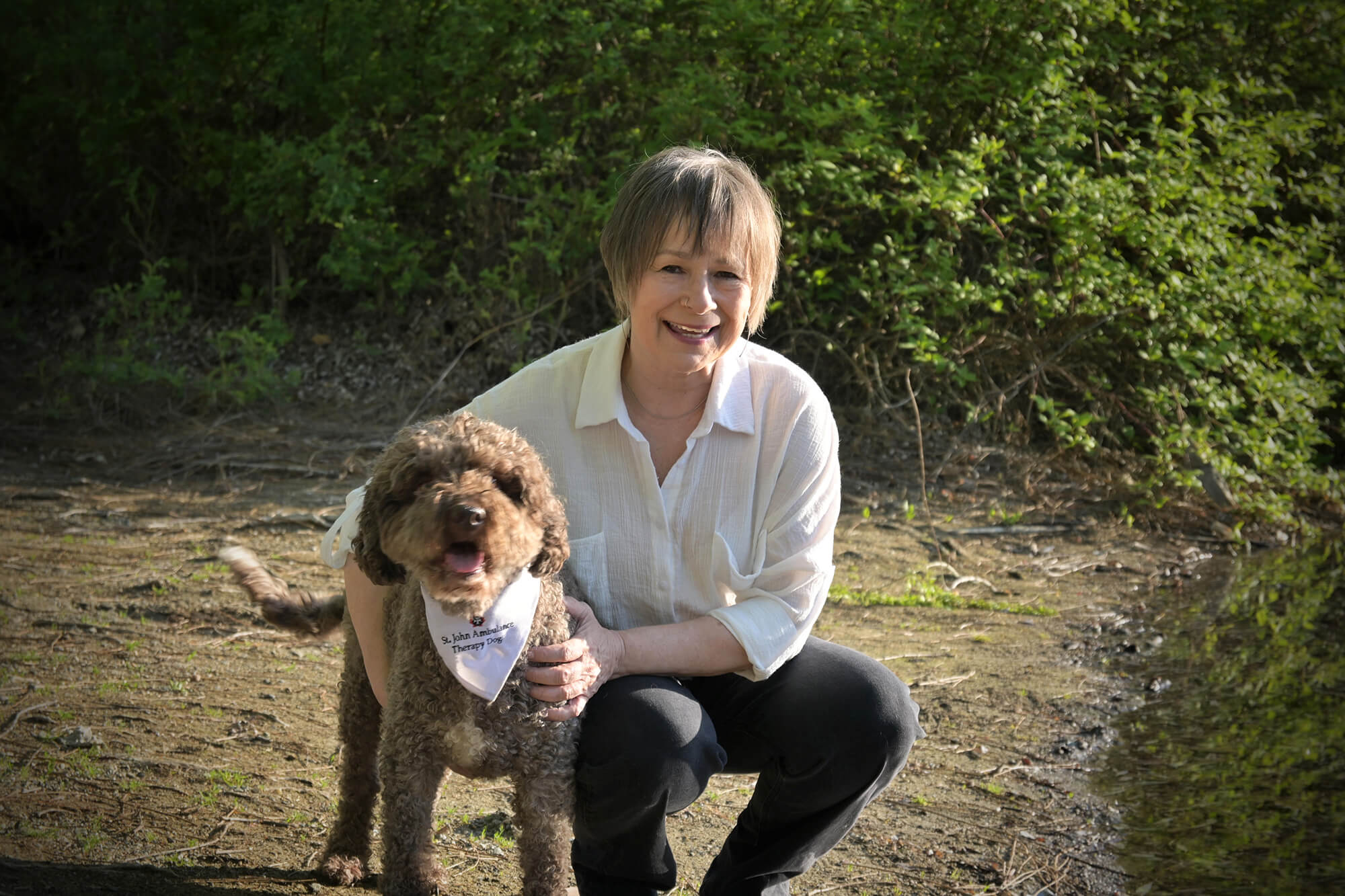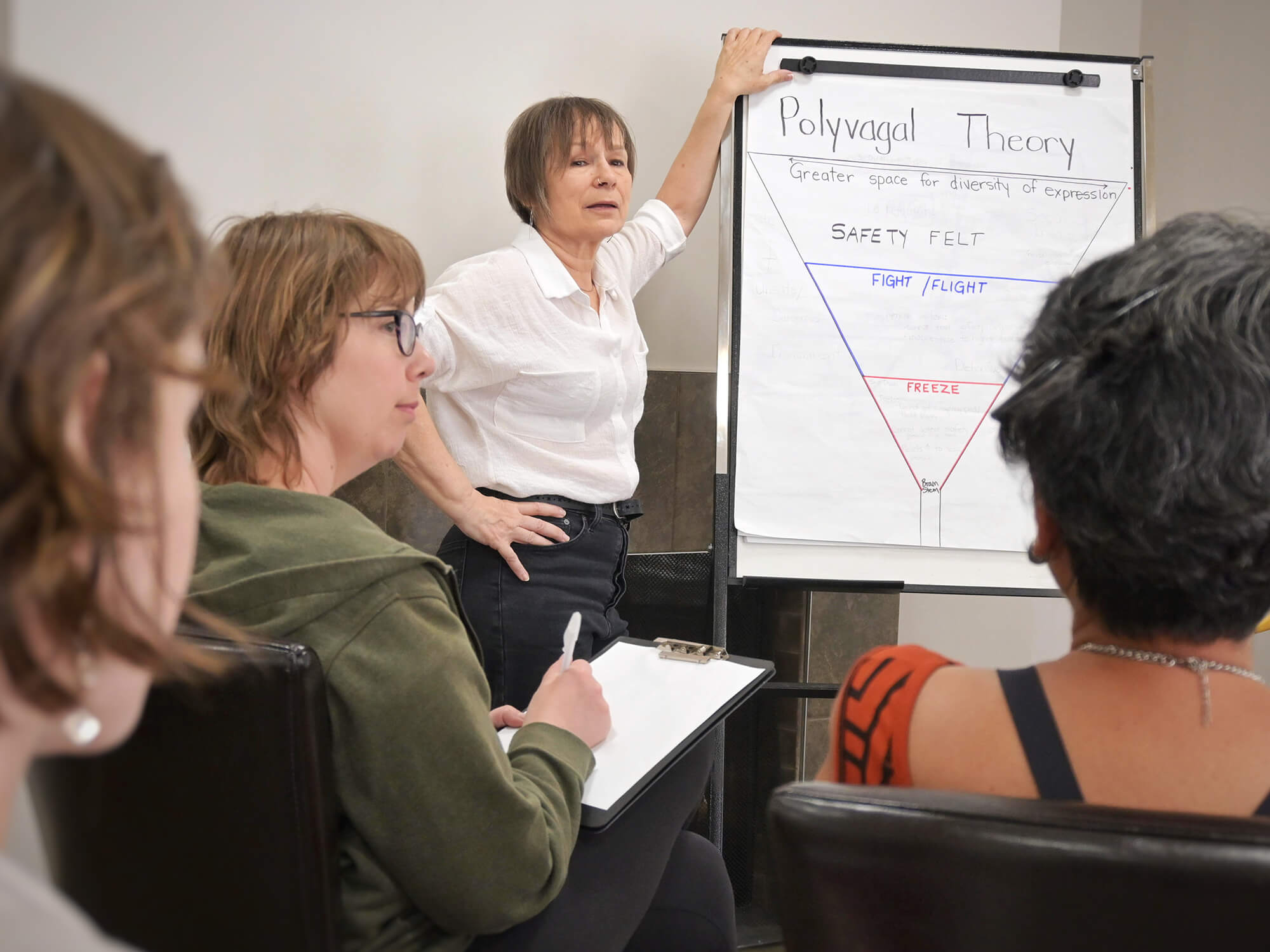Hansen Counselling & Consulting
Nurturing Personal Health & Well-Being
Guiding people to connect to their inner selves somatically.
Meet Lois Hansen, MEd, SEP
At Hansen Counselling, I am honoured to be making a meaningful difference in my client’s lives. Counselling can range from personal, relational, or professional growth to the most complex of trauma issues, serving individuals, couples and groups. Through my somatic counselling approach I aim to provide not just compassion, but a clear, guided pathway to healing that respects the complexity of your experiences.

Lois Hansen holds a Masters of Educational Counselling degree from the University of Victoria, is a Registered Somatic Experiencing® Practitioner and is in good standing with the Canadian Counselling and Psychotherapy Association.
Lois resides in Lake Country and enjoys nature, yoga and the beautiful Okanagan weather.
Somatic Experiencing® Practitioner
Through the Somatic Experiencing Trauma Institute, Lois is also a Somatic Experiencing® Practitioner, approved assistant for SE training and a personal and professional session provider for participants in all levels of the training.
Fully Trained in the
Following Modalities:
- Somatic Experiencing®
- Therapeutic Touch Therapy
- Gottman Couples Counselling
- Human Sexuality
- Strength Based Practice
- Internal Family Systems (parts work)
- Mindfulness Practice
- Child-Centred Play Therapy
Cognitive Behavioral Therapy
Techniques:
- Cognitive Restructuring
- Systematic Desensitization
- Guided Imagery or Visualization
- Covert Modeling
- Problem-Solving
Somatic Experiencing® is the strongest influence in each counselling session.
One-on-one
Counselling
My one-on-one comprehensive somatic counselling sessions are tailored to your unique needs, ensuring that every strategy and tool provided is suited specifically to your journey towards healing.
Hansen Counselling Offers:
- One-on-one Counselling
- Couples Therapy
- Family, Parenting, and Youth Counselling
- Group Therapy
- Counselling Through Telehealth
- Zoom Sessions
- Touch Therapy
My Approach
A Network of Healing
I have 13 years of specialized training, with 25 years of counselling experience and my approach is collaborative. While being referred to as a highly skilled healer, I do not work alone. A network of expert mentors and specialists are readily available to consult with and assist me, ensuring comprehensive support for all my clients. Each client’s journey is unique. I avoid a one-size-fits-all method, opting instead for interventions that are directly relevant to each personal circumstance. This ensures that time in therapy is focused and effective.
Real Results for Real People
My clients come from all walks of life, each with their own stories, struggles and strengths. From psychiatrists, lawyers, teachers and dentists to plumbers, carpenters and first responders – my methods have proven effective across a diverse demographic. About 35 percent of my clientele are from the indigenous community, dealing with effects of intergenerational trauma. At Hansen Counselling, healing isn’t just an idea. It is a reality, shaped by your willingness to engage and apply your new learning and my commitment to your growth.

5 Sessions
Lowering Anxiety Through Self-Regulation© Training
Learn to manage anxiety through self-regulation in these specialized classes. Each session is designed to be accessible. You will be provided with the tools you need to achieve calm, balance your central nervous system and your life.
Therapist Mentorship
Support for Therapists
Having worked with therapists from Sydney, Australia to Kelowna, BC, I offer experience, support and training. Professionals are equipped with the skills to support their clients effectively using a somatic perspective.
Using A Somatic Lens is a class offered to therapists who are interested in learning how to apply a somatic lens to their counselling.

Questions & Answers
Blank
What Is Somatic Experiencing® Therapy?
rSomatic Experiencing® Therapy (SE) is a body-oriented approach to personal healing, including trauma and chronic stress. It was developed by Dr. Peter Levine, based on over 45 years of research in stress physiology, ethology, psychology, biology, indigenous healing practices and medical biophysics, including the most recent and relevant brain-based research and how to release the wounds of early developmental attachment and/or trauma. The method focuses on helping people release unresolved trauma that is stored in the body—not just the mind.
Core Concepts of Somatic Experiencing®:
1. The Body Holds Trauma
Unlike traditional talk therapy that focuses on the story or memory of a traumatic event, SE emphasizes how trauma energy is held in the nervous system and the body. This includes physical sensations, tension, or feeling stuck, resulting from incomplete fight, flight, or freeze responses.
2. Trauma as Incomplete Survival Responses
In nature, animals automatically discharge survival energy after a threat has passed. Humans, however, often don’t complete these responses due to psychological, cultural, or developmental factors. This leads to “stuck” energy that manifests as anxiety, fear, rage, numbness, or disconnection.
These stuck responses can manifest as sensations of helplessness, rage, or collapse, all of which stem from incomplete or thwarted self-protective actions. When these responses are not allowed to fully discharge, they remain in the nervous system and continue to disrupt a person’s sense of well-being and connection.
3. Window of Tolerance
A concept adapted from Dan Siegel, PhD, a Clinical Professor of Psychiatry at the UCLA school of Medicine, the window of tolerance describes the optimal zone where a person can function effectively. Trauma pushes individuals outside this window, leading to either hyperarousal (panic, anger) or hypoarousal (a sense of fogginess, numbness, shutdown). SE helps client access, expand and stabilize this window.
4. Titration and Pendulation
SE uses titration, the careful and incremental processing of traumatic material, and pendulation, the gentle shifting between states of discomfort and safety. This avoids retraumatization and supports nervous system regulation.
5. Listening to the Body
Clients are guided to become more aware of internal sensations (interoception), allowing them to notice and respond to their body’s signals with mindfulness. This helps shift their system out of chronic survival states and into healing.
The goal of Somatic Experiencing® is to
- Release unresolved trauma energy stored in the body
- Restore natural regulation to the nervous system
- Which automatically resolves symptoms such as anxiety, chronic pain, or emotional dysregulation
- Strengthen inner resilience and coherence
- Deepen self-awareness and reconnect to the present moment
- Empower the client to access their natural healing capacities
Through this work:
- Clients are encouraged to listen to their bodies and respond authentically, connecting to their past not just through narrative, but through somatic awareness and presence.
- Resilient and coherent inner resources are identified and reinforced, helping clients anchor in strength while exploring difficult material.
- Traumatic material is processed in titrated amounts—small, manageable steps—ensuring the process is neither overwhelming nor ineffective.
- Safety, relationship, and connection—to self, others, and the environment—are deepened through this individualized approach.
- Whole-body balance is emphasized, focusing on the regulation between different physiological and emotional systems rather than treating trauma as a single symptom.
- Therapies are chosen that touch the deeper layers of body, psyche, and spirit—meeting trauma where it has left its most profound effects.
By using these mindful, body-centered interventions, clients are guided toward releasing the undischarged energy held in the body. As a result, trauma symptoms often become significantly reduced—or disappear altogether.
Common Client Reflections:
People often seek SE after other therapies have not resolved deep-seated emotional or physical responses. Common statements include:
“I don’t know why I can’t get over this,”
“Nothing has ever helped long-term,”
“I feel stuck, like something’s holding me back.”
These experiences typically point to unresolved trauma energy that SE is uniquely equipped to address.
To summarize, Somatic Experiencing® is not about reliving trauma but about safely and gently guiding the body and nervous system toward completion, regulation, and healing. By helping the body release stored trauma energy, clients often find lasting relief from symptoms and most often, with this release, symptoms disappear and there is a return to their fuller, authentic selves.
What Types of Trauma Do You Commonly Treat?
- Shock Trauma
A one-time or short-term traumatic event, such as a car accident, natural disaster, sudden loss, or assault. - Developmental Trauma
Trauma experienced during key stages of development, including in utero, infancy, childhood, adolescence, or adulthood—often involving neglect, unmet emotional needs, or chronic stress. - Intergenerational Trauma
Trauma passed down through family systems, potentially affecting clients via the experiences of parents, grandparents, or extended relatives—even when the original events are not consciously remembered. - Complex Trauma
A combination of any or all of the above types, often involving chronic exposure to traumatic stress and difficulty with regulation, relationships, and a sense of safety.
Does Experiencing Trauma Indicate Weakness or Brokenness?
People who have encountered overwhelming experiences may present with symptoms that are difficult to articulate or define. Common challenges include feeling robotic or emotionally disconnected, experiencing persistent fear or anger, or a sense of being stuck—unable to “get over” something no matter how hard they try.
When a person experiences something overwhelming—such as an assault, car accident, or childhood neglect or abuse—the emotional and physiological imprint of that experience doesn’t simply disappear once the event is over. Trauma is energetic and far-reaching. Its effects can continue for years, disrupting not only the life of the individual, but also the lives of those around them. The central nervous system retains this traumatic energy, resulting in a dysregulated state. This can occur whether the traumatic event was fully understood or not, spoken or unspoken.
It is a common misconception that people who have experienced trauma are fragile or broken. In truth, these individuals are often among the most resilient—having endured incredibly difficult experiences and continuing to live their lives with remarkable strength. However, while they demonstrate resilience outwardly, their internal coping strategies may be held together by tenuous threads. This can result in a pervasive, and sometimes overwhelming, sense of fragility.
Understanding how the body stores trauma, and how sensory systems such as interoception (internal body awareness), exteroception (perception of the external world), and proprioception (awareness of body position and movement) impact our functioning, can be a key to resolving trauma symptoms, restoring these systems to balance supports a return to the body’s natural resilience.
What is the Strongest Factor To Help Protect Individuals From the Effects of Traumatic Stress?
According to Kathy Kain, PhD, and Stephen Terrell, PsyD in their book, Nurturing Resilience, they state that long term healthy bonding which gives access to co-regulation (healthy relationships) and the eventually, sometimes immediately, this co-regulation assists in the development of self-regulation. Access to self regulation is what protects people from the effects of trauma.
What Are the Key Elements for Developing Self-Regulation After Trauma?
Safety and security, a sense of connectedness, are the keys to unlocking self-regulation.
Learning about how to connect is vital. That is why the training entitled Lowering Anxiety through Self Self-Regulation© training, was designed.
It was created after noticing that most people need to learn similar information regarding the somatic approach. Compiling the best of her 13 years of university level trauma education, this training is offered as an alternative to, or along with individual counselling. It is capped at 10 participants and is offered 2 times per year, in January and in September. The workshop consists of 5 sessions that are one and a half hours long.
What Protective Factors Promote Resilience in Children Facing Significant Adversity?
In their book Nurturing Resilience, Kathy Kain, PhD, and Stephen Terrell, PsyD, state the answer is:
At least 1 stable and committed relationship with a supportive parent, caregiver or other adult.
Other identifiable factors are:
A sense of self-efficacy and perceived control, sources of faith, hope and cultural traditions, a supportive adult-child relationship, adaptive skills and self-regulatory capacities.
Do You Provide Counselling Services for Children?
According to the World Health Organization, anxiety disorders are the fastest growing mental illness in adults, children and youth today, affecting 301 million people in 2019. Why is this? Although there is no one simple answer, it is clear that today’s children seem to be confronted with a dichotomy.
On one hand they are subjected to television, movies, computer and electronic games that give them an entertaining yet isolating experience everyday. While they have wonderful entertainment they often are not experiencing direct human connection. Further, they are part of a society that, by the very nature of its evolution, provides fewer intimate moments. Our homes are bigger, causing less incidental interaction. Involvement with extended families is often less frequent, religious affiliations are often weaker, creating little, if any support from the grandparents or church community. More families have both parents working, or single parent homes, resulting in children spending more time alone or with preoccupied adults, leading to children feeling more alone.
According to M. A. Barnes, in his book, The Healing Path with Children, a study stated that from 1965 to 1989 the amount of time parents spent with their children dropped 80%. What do you think that number would be presently? At the very least, it has not improved.
Parenting can feel almost impossible in Canada as there is very little space for it in our society.
While raising children, parents are often also trying to sustain a career, make an income, keep our social connections and prove to ourselves that we are up to all the tasks. Over and over therapists hear accounts of parents who are under excruciating pressure, feeling pulled to be a parent while pulled to responsibilities that take them away from the parenting role.
Parents are offered support during this very challenging time and given strategies equipping them to be the best parents they can be.
While counselling is available for children and teenagers who have experienced trauma, it has been found to be even more effective for therapist to work with the parents of the child or teenager and to train the parents how to respond while ‘in the trenches’ so to speak, when the child or teenager needs specific support. Lois has found that this type of intervention has been highly productive for the child, or teen, the parents and the whole family.
Her approach is using a trauma lens and noting the activation of the central nervous system of each family member including the child. Psycho-education and tools are presented to teach parents to monitor and lower activation of the central nervous system. Basic parenting tools are taught to the parents and practical suggestions are offered. Many parents have expressed that this type of intervention has been extremely helpful to them. They learn how to apply appropriate boundaries and supports for themselves, and their children’s optimal growth and behaviour. Recognizing old and often invisible patterns of behaviour are also significant in determining the most helpful way to intervene for each child or teenager. As well as taking in to consideration the impact of earlier experiences for each child or teenager as well as their parents.
